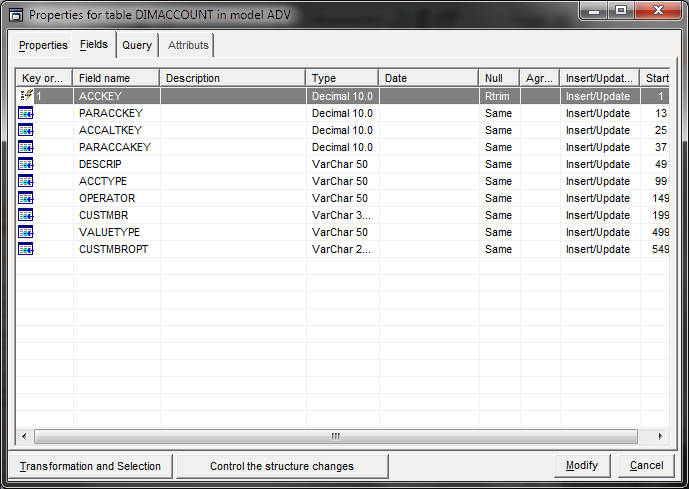Fields tab

The tab contains various actions on the fields of the output buffer. This buffer corresponds to the input buffer if it has not been redefined partially or entirely using the transformation module.
Key order
This column indicates all the fields with their order, which defines a unique key for accessing the record on the target table.
Talend Change Data Capture needs this key definition if the target table is accessed using a key or SQL to determine the key (key access) or the Where statement (SQL access).
The key is not required if the following criteria are met:
-
The target table (AS/400 IBMi only) is accessed using the rank number.
-
The target table receives only add instructions, and no check for duplicates is required.
In the other cases, a key is necessary to determine the target record to update or delete. In case of adding operation, it is also needed to determine if the target record already exists.
By default, when adding a table, Talend Change Data Capture automatically retrieves the key descriptions of the AS/400 IBMi file or the Primary Key constraint for the other sources.
If no key has been defined or if the key cannot be used for the target, you use this field to specify the key composition.
Field name
This specifies the field name. This is either the source file field name or the name defined in the transformation module.
Description
This field is used to enter a description for the selected field. The description is retrieved from the source file, by default.
Type
This property specifies the field type.
Date
This property specifies whether the field contains a date, whether it must be used for an SQL date-type field (excluding AS/400 IBMi), and its storage format.
For example, if the field in AS/400 IBMi contains a date stored with four digits for the year, two digits for the month and two digits for the day, you select the YYYYMMDD format.
In the formats, the following abbreviations are used:
-
C stands for the century (0=19, 1=20),
-
Y for the year,
-
M for the month,
-
D for the date,
-
HHMM stands for the hour using two characters followed by the minutes using two characters,
-
HHMMSS stands for the hour using two characters followed by the minutes using two characters, and the seconds using two characters.
In case of using two characters (YY format) to indicate the year, the resulting year for the 4-character format would be 20YY if YY<40, and 19YY if YY>40.
If you want to apply a rule other than the standard rules, you must use the transformation module.
Null
This property specifies whether a null value must be sent for an empty field to an SQL database (excluding AS/400 IBMi), based on these rules:
| Null | Type | Rule |
|---|---|---|
| Yes | Alpha | The blanks to the right are deleted, and if the field is empty, then the Null value is sent. |
| No | Alpha | The blanks to the right are not deleted. |
| Rtrim | Alpha | The blanks to the right are deleted, and if the field is empty, " " is sent. |
| Same | Alpha | Sent data exactly correspond to what is received or calculated. Empty are empty, null are null and varchar are varchar, as they are in the source. |
| Null | Type | Rule |
|---|---|---|
| Yes | Numeric | If the value contained in the field is 0, then Null is sent. |
| No | Numeric | If the value contained in the field is 0, then 0 is sent. |
| Same | Numeric | No processing, null are null, 0 are 0 |
| Rtrim | Numeric | Same result as for No. |
Aggregate
This property specifies whether the contents of the column are totaled on the target (aggregate management).
Insert/update
This shows when the field / column is used
-
Insert/update
The field/column is used after the inserts and updates.
-
Insert
The field/column is used only after inserts.
-
Update
The field/column is used only after updates.
-
Never
The field/column is never used but it is sent to the target to be used for, e.g., transformations.
Start
This property is the start position in the buffer (O).
Did this page help you?
If you find any issues with this page or its content – a typo, a missing step, or a technical error – let us know how we can improve!
